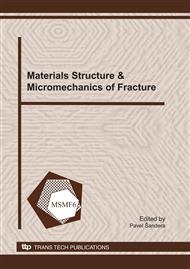p.495
p.499
p.503
p.507
p.511
p.515
p.519
p.523
p.527
Mechanisms of the 2024-T351 Al-Alloy Fatigue Cracking in Bifurcation Area after Laser Shocks Hardening Procedure
Abstract:
The fatigued specimens have attested the surface hardening of the 2024-T351 aluminum alloy based on the laser shock peening (LSP). Tests were carried out with simple regular specimens bending. It was shown that each crack started from or near to the specimen-hardened surface of the thickness 4mm. The hardened surface layer influenced material fatigue cracking on the Stage I of crack growth as well as on the Stage II where fatigue striations formation mechanism takes place. Parameters of S-N curves were analyzed for tested specimens and bimodal distribution of the fatigue durability (BDFD) was revealed. The left branch of the BDFD attested fatigue behavior of not hardened material. The right branch of S-N curves attested the material behavior after surface-hardening procedure by the LSP technology. The paper discussed mechanisms of material fracture in the bifurcation area for the stresses interval ranged from 270-295 MPa where transition from the left to the right branch of the discovered BDFD takes place. The subsurface crack origination occurs for the right branch of BDFD because of twisting of material volume under combination of material compression in a local area of crack origination with gases diffusion in the volume of crack origin.
Info:
Periodical:
Pages:
511-514
Citation:
Online since:
January 2011
Authors:
Keywords:
Price:
Сopyright:
© 2011 Trans Tech Publications Ltd. All Rights Reserved
Share:
Citation:


